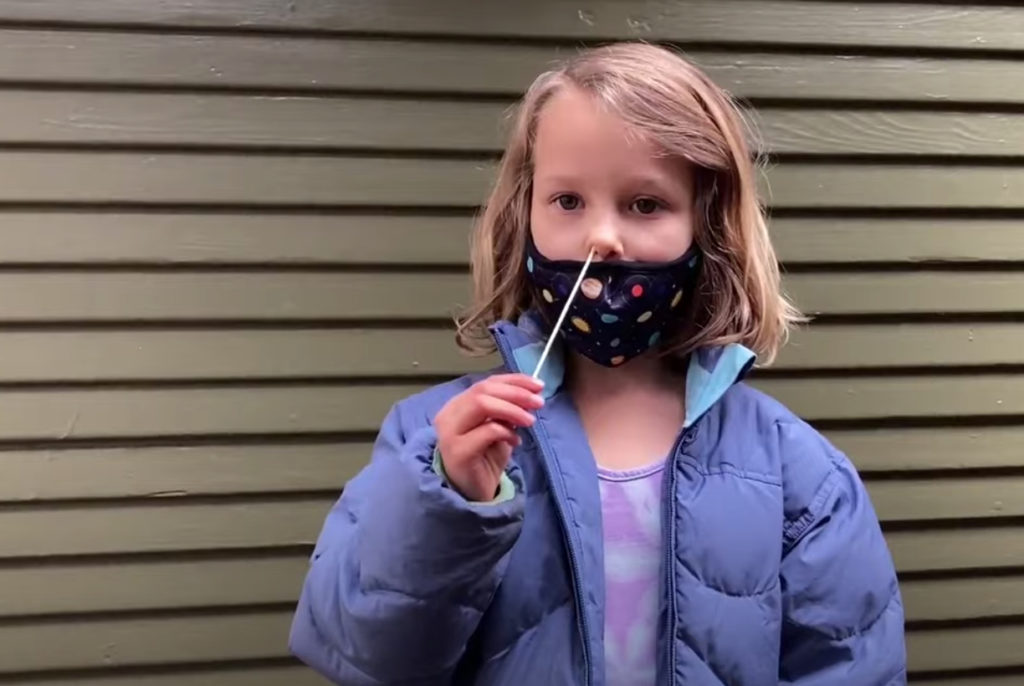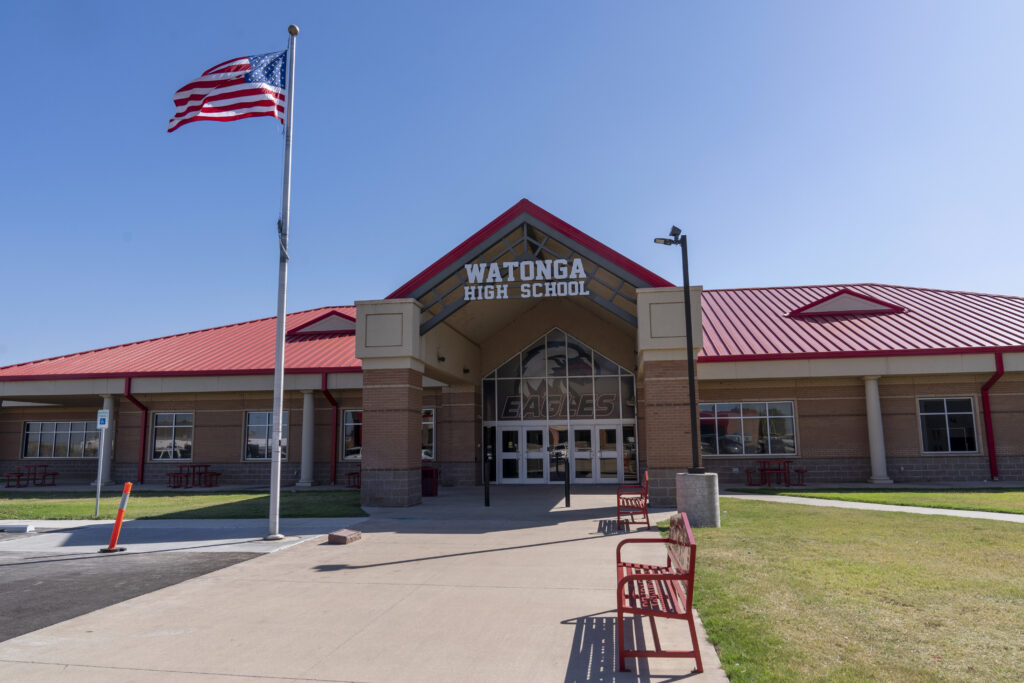
An elementary school student demonstrates using a swab for the rapid Covid antigen test.
Credit: California Department of Public Health
COVID-19 cases are on the rise throughout Los Angeles Unified and the county. Public health experts are urging caution while school officials are looking to keep children in the classroom for their academic progress and emotional well-being.
“We want kids in the classrooms learning,” said Sarah Van Orman, the University of Southern California’s vice president and chief campus health officer. “That’s what we’re all doing — whether that be in K-12 or in higher ed — balancing the need to prevent … respiratory illnesses within our communities with the need for people to … engage in the activities that they need to engage in, which includes learning at the K-12 levels.”
Despite the surge in cases, LAUSD has maintained a 95% attendance rate this school year as of Wednesday, according to the district’s attendance tracker. Over the past five days, that number was lower at 93%. And 94% of students went to school on Wednesday.
“Obviously, the unexcused absence student is going to take a higher level of priority, but in terms of impact, there’s really no difference,” LAUSD Superintendent Alberto Carvalho said. “Kids who are absent are absent.”
Increased rates of COVID-19
In a weekly update issued Wednesday, the Los Angeles County Department of Public Health reported an average of 569 daily Covid-19 infections and 559 daily hospitalizations excluding Long Beach and Pasadena — topping five weeks of steadily rising cases.
In schools, however, LA County has observed a 43% increase in cases and 33 new outbreaks in the past week — 23 more outbreaks than the previous week, according to an LA County Department of Public Health news release issued Thursday.
EG.5, a variant of Covid related to omicron already infecting more people than any other single strain in the country, remains dominant, accounting for nearly a third of current cases in the sector of the U.S. including California.
An Aug. 24 news release from the county public health department attributed the rise of Covid infections to higher rates of summer travel, the emergence of a new variant and a return to the classroom.
With increased Covid-19 transmission in the community, schools are another place where outbreaks are possible due to large groups of people being indoors together for extended periods of time, according to the release. And while many children may not experience severe illness associated with a Covid-19 infection, other family members and school staff may be at higher risk.
The county also urged parents and guardians to “keep children home if they are sick, including when they have a fever, bad cough, extreme fatigue, or a sore throat.”
Students who are exposed to Covid or have respiratory symptoms should get tested, the department stated, noting that many districts were already distributing tests to their campus communities.
Positive test results, the department said, should be reported to the school, and the sick student should isolate for at least five days.
Keeping students healthy could also be critical in maintaining a healthier community. One study published earlier this year suggested that about 70% of U.S. cases begin with a school-age child being infected.
More than a year ago, the beginning of the 2022-23 school year also was associated with a surge in Covid infections.
For then-4-year-old Jackson Siegel and his older sister, that fall marked a return to in-person learning as both had been kept home the entire preceding year. It also marked the beginning of a wave of sickness.
During the first week of school, Covid made its way from Jackson’s sister’s third grade classroom to her and then to Jackson.
He missed 10 days of transitional kindergarten and was out again for another 10 days roughly every three weeks — sometimes sustaining a fever of over 104 degrees.
“To be honest, I think that I’ve been sick … more times in school than my friends,” Jackson said. “It makes me feel like I should be safer.”
That routine repeated itself another seven to eight times, according to his mom, Sabrina Siegel.
“The fact that they caught it in the first week, I was devastated,” Siegel said. “To the school, [I] said, ‘Look, if you don’t care enough about my kids’ health to, you know, require masks or have kids [sent] home when they’re sick … I don’t care about the attendance.’”
Jackson said he looks forward to not being sick this year.
But as of Thursday, LAUSD alone had 828 positive tests over the past seven days, which comes amid changes to the district’s public health guidelines that contradict public health guidelines, where parents are now encouraged to send their child to school even if they are experiencing cold symptoms.
Current district guidelines require students to stay home if they sustain a fever of above 100.4 degrees — or if they vomit, have diarrhea, severe pain or labored breathing.
Keeping students in class
As Covid cases continue to rise, LAUSD and districts across the state have been working to recover from pandemic learning losses and keep students in school.
“The greatest effect from the pandemic that I have seen in children has been the emotional trauma from missing school,” LAUSD’s chief medical officer, Dr. Smita Malhotra, said in a message to the district community at the start of the academic year.
“Schools are foundations of resilience, and I look forward to ensuring that schools continue to be the safest places for children to be so that all students thrive academically, are engaged and are ready for the world.”
LAUSD experienced a 40% absentee rate in the 2021-22 academic year. The following year, that number fell by 10 percentage points to roughly 30%. The district has largely attributed the decrease in chronic absenteeism to iAttend events, where school officials go door to door to encourage students, mainly with unexcused absences, to return.
“This new wave of Covid is coming in at such a difficult time,” said USC education professor Julie Marsh. “You know, schools have just started, and I think that’s also historically a time where you try to make up for summer learning loss.”
Keeping students in school is also critical because “for many kids, it’s their only place where they have access to regular food resources, health care, after school care,” Marsh said.
Part of LAUSD’s incentive to curb chronic absenteeism also could lie in its coffers, Marsh added, noting that school funding is linked to students’ attendance.
“If the financial implications are really what’s driving some of these decisions, then I think it’s calling for larger policy change,” Marsh said. “There’s been a long-standing debate about whether California should fund the schools based on enrollment versus attendance. Lots of states do it based on enrollment. But I just have to wonder, if a district felt a little less concerned about losing funding, whether … we’d be seeing different kinds of policies.”
A balancing act
Balancing students’ health with being in the classroom is critical, experts say.
Marsh said she and her colleagues conducted a study at the start of the pandemic that found clear communication with the community, mental health support for staff and partnerships with local organizations and public health departments were critical.
She added that schools should continue to take advantage of technological tools popularized during the height of the pandemic, while parents should “trust [their] gut” when deciding whether to send their child to school.
“You also don’t want to send your kid to school if they’re not well enough to learn. Is your kid impacted by the symptoms?” Marsh said. “You kind of have to understand where your child is at and whether they’re ready to learn.”






)
)